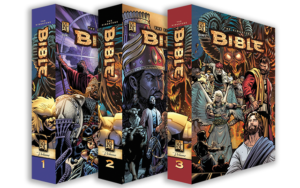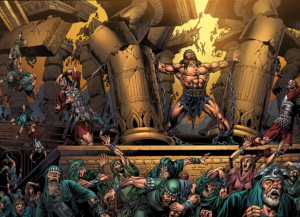The Kingstone Bible

BOOKS EDITED BY ART A. AYRIS
KINGSTONE COMICS, 2016
2,053 PP. IN THREE VOLUMES, $74.99
ONE OF MY CHILDHOOD memories of United Presbyterian Sunday school is the fun I had reading full-color comics telling Bible stories and Greek myths (which I believed equally!) Such things have been many a child’s initiation into the special world of Christianity, and of course other religions have also employed superhero tropes and visual approaches to attract young people.
One of the latest Christian treatments is counterculture comic book artist Robert Crumb’s Book of Genesis (2009), a graphic novelization of all fifty chapters of the Bible’s first book, closely following a text he created out of the King James Version and the translation of Robert Alter.
Now comes the most ambitious such treatment ever, the Kingstone Bible. In hardcover it consists of three hefty volumes with a combined weight of 12.4 pounds, encompassing 2,023 full-color pages of story material. The artwork is the product of serious professionals in the field, almost all of whom have worked with DC and Marvel comic book publishers.
Unlike previous popular renderings, the Kingstone Bible gives its attention to the biblical stories rather than attempting to cleave consistently to the biblical text. In the process it retells the narratives as action adventures seen through an evangelical Christian lens.
Nothing demonstrates this bias more clearly than page one. We see a dark sky with three points of light accompanied by the following text, referenced as coming from Genesis 1:1-2:
In the very beginning—even before time was created—there was God. He existed in three persons—co-equal—co-eternal but one in essence. God was not lonely—He communed with himself in harmonious love. Then it was He . . . who created the heavens and the earth. [Ellipses in original.]
This isn’t strictly biblical; it’s a clarification of Christian doctrine. Thus, right out of the box the game is rigged against any Jewish, Muslim, or secular reading of what originated as Jewish scripture.
Page one is followed by a series of evocative two-page spreads as the text of Genesis 1:3-25 is closely tracked. But then the book skips most of the end of Genesis 1 and the beginning of Genesis 2 in order to make a smooth transition from the announcement of the sixth day of creation to the creation of Adam, Eve, and the Garden of Eden. By contrast, Crumb’s Book of Genesis sticks to the text, going so far as to draw attention to the fact that there are two different creation stories here. And because the Kingstone Bible departs from the text in the way it does, it finds no place to mention the seventh day when God rested.
Beyond this effort to edit the text into a single cohesive story, the Kingstone Bible tries to explain, in modern scientific terms, how some parts of the Bible might be considered historically workable. Take for example the matter of Adam and Eve’s many children, who grow up to have families of their own. One panel reads:
Adam and Eve, as the first creation of God, were genetically perfect and as a result the first generations lived long life spans—many hundreds of years. In the beginning, family members married close relatives. Mutant genes that cause deformities had not yet come into the gene pool. (Later, through Moses, God forbid the intermarrying of close relatives.)
Of course no such references to modern genetics appear or are implied anywhere in the Bible. Moreover, this pseudoscientific material is used to replace the itemization of the generations after Adam and Eve (all of Genesis 5). So if you yearn to see what a full chapter of “begats” can look like when graphically illustrated, you’ll have to look elsewhere.
Another part missing from the Kingstone Bible is any representation of Genesis 6:1-4, where we are told that the “sons of God” saw how beautiful the “daughters of men” were and raped them, fathering children who went on to become the fabled giants of old.
The second section of the Kingstone Bible is called “Noah” and gets underway with newly invented material that has Noah’s three sons visiting a local village to buy supplies for the Ark. When all the goods so far purchased are left in the care of Japheth, the other two brothers, Ham and Shem, head off to negotiate with a blacksmith. At this point a prostitute approaches Japheth. When he refuses her advances she departs. But this distraction allows him to be knocked on the head by unseen parties who steal all his stuff. Ham and Shem return, forgive the wounded Japheth, and take him to a tavern for lunch. There the brothers are mocked by other patrons for trying to build a giant boat in a dry field. This gives Shem an opportunity to tell of the coming flood. But only one young woman listens, and she subsequently becomes Shem’s wife.
This makes for a useful cautionary tale, perhaps worthy of the Bible, but it just isn’t in there.
On the positive side, at the end of the Noah section we get an awesome two-page spread of the Tower of Babel, the sort of thing appropriate for any good graphic novel. Indeed, the Kingstone Bible features many such large and visually arresting illustrations.
And this reflects what the editor, Art A. Ayris, explained to me about the art. “Some of our artists subscribe to faith, some don’t. I am not asking them to teach Sunday school but to draw historically accurate and great comics.” And indeed, this treatment of the Bible isn’t Sunday schoolish in its illustrations. But it is certainly churchy in terms of its message.
 For example, at the end of the third section, treating the Book of Job, a full page of text is devoted to explaining the book’s meaning in evangelical Christian terms. Moreover, this is the eighteenth book of the Bible but is inserted into the middle of the Genesis 11 narrative, where it doesn’t really belong in terms of when Job is usually claimed to have lived. And the story, with its repetitive dialogue, is given a whopping sixty-two pages—clearly a centerpiece for Christian evangelizing.
For example, at the end of the third section, treating the Book of Job, a full page of text is devoted to explaining the book’s meaning in evangelical Christian terms. Moreover, this is the eighteenth book of the Bible but is inserted into the middle of the Genesis 11 narrative, where it doesn’t really belong in terms of when Job is usually claimed to have lived. And the story, with its repetitive dialogue, is given a whopping sixty-two pages—clearly a centerpiece for Christian evangelizing.
When we get to the story of Moses, the dramatic imagery is a little too familiar, reminiscent of Charlton Heston in The Ten Commandments. But much of the brutality is faithfully rendered, such as when, after the exodus, Israelite men fornicate with Moabite women and adopt the latter’s idolatries, leading Moses to hang the disobedient Israelites in broad daylight (Numbers 25:1-9). But the Moses narrative doesn’t continue to the Midian War where, the Bible says, after the Israelite victory when all the Midianite men had been killed, Moses gives an ethnic cleansing order to his officers (Numbers 31:17-18):
Now therefore kill every male among the little ones, and kill every woman that hath known man by lying with him. But all the women children, that have not known a man by lying with him, keep alive for yourselves.
This problem continues off and on throughout. Despite the promise of gripping imagery in a graphic novelization, there is an occasional muting or skipping over certain biblical horrors, apparently so the work’s audience can include preteen readers.
Moreover, from the standpoint of the typical graphic novel reader, the Kingstone Bible tries too hard in too obvious ways to nail down doctrine and preach the faith. Yes, this treatment is far more subtle than a Jack Chick pamphlet, but the publishers are clearly playing to their market.
I asked Ayris about this. He replied: “The largest revenue stream for Kingstone is licensing, as we have licensed the Kingstone Bible for animation and also into several languages. Secondarily will be retail through Amazon, retail chains, and independent stores. After those two would come church bookstores and churches.”
As televangelists and Christian businesses have long known, preaching to the choir makes more money than preaching to the unconverted. So it probably doesn’t much matter to the publisher that this effort fails as a stealth technique for introducing the Bible to rank-and-file action-hero comic fans and graphic novel readers (they’ll see this one coming). But the art and storylines will certainly prove compelling to young Christian evangelicals who also enjoy comics and graphic novels.
In Volume 3 we are given the New Testament. But it doesn’t cover the Gospels in book order, opting instead to just tell the story of Jesus, grabbing pieces from the various gospels in story order. This approach actually makes the best sense for a graphic novelization. We are then treated to the Book of Acts, the various epistles, and finally the Book of Revelation.
This last became my Halloween reading, and it is a holy horror, offering some of the most grotesque illustrations since the heady days of horror comics in the early 1950s. (So much for sparing preteen readers here.)
It begins with the author, John, in exile on the island of Patmos, living alone in a cave. There he receives a visitation from Christ. And what a terrorizing ghost this son of God is! I’ve never seen Jesus depicted in such an outright creepy manner.
Jesus orders John to write down all sorts of bizarre prophesies of the future, accompanied by a grisly parade of fantastic visions. For years I’ve thought it would be instructive to see this material illustrated just as the text describes, and the Kingstone Bible doesn’t disappoint.
But then there’s a problem. Footnotes are inserted to attempt to explain some of these incredible occurrences in naturalistic terms. For example, to apply a little science to Revelation 6:13—“And the stars of heaven fell unto earth”—we are told, “This is likely a massive meteor or asteroid shower that strikes the earth.”
Unfortunately, that leaves the reader of the Kingstone Bible in as big a quandary as a reader of the regular Bible. Which of these alleged future events are supposed to actually look the way they are depicted or described, as opposed to merely being symbolic? Consider the second beast who, according to Revelation 13:11, “had two horns like a lamb but he spake as a dragon.” The two-page illustration of this outstandingly hideous monster doesn’t seem to match the footnote that describes him calmly as “a military and political leader.” So I’m mystified as to what I’m being asked to believe.
This brings me to a conclusion I’ve often drawn. Many who love the Bible get excited about treatments like this, seeing them as great recruiting tools. But making the Bible more accessible often serves to make its problems clearer. So, if you have friends who believe in the Bible while never having really read it, this could be the perfect gift for waking them up to its true mythical nature.
